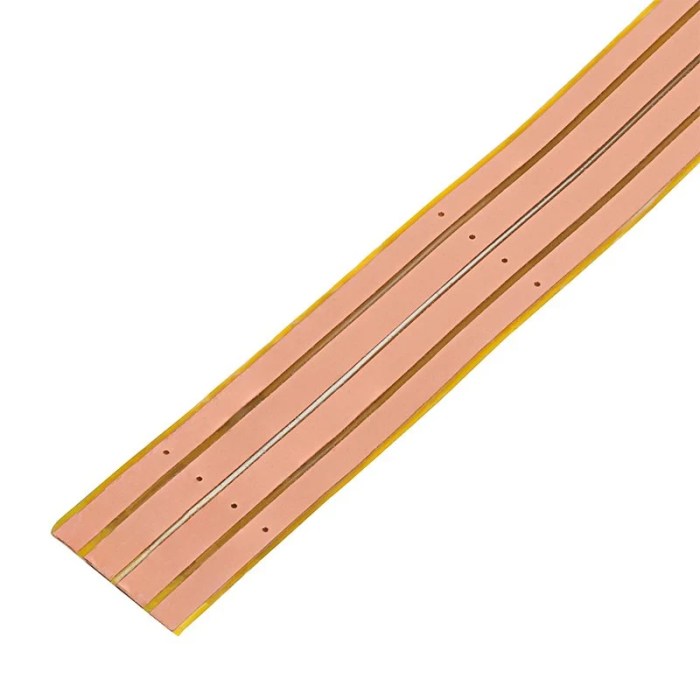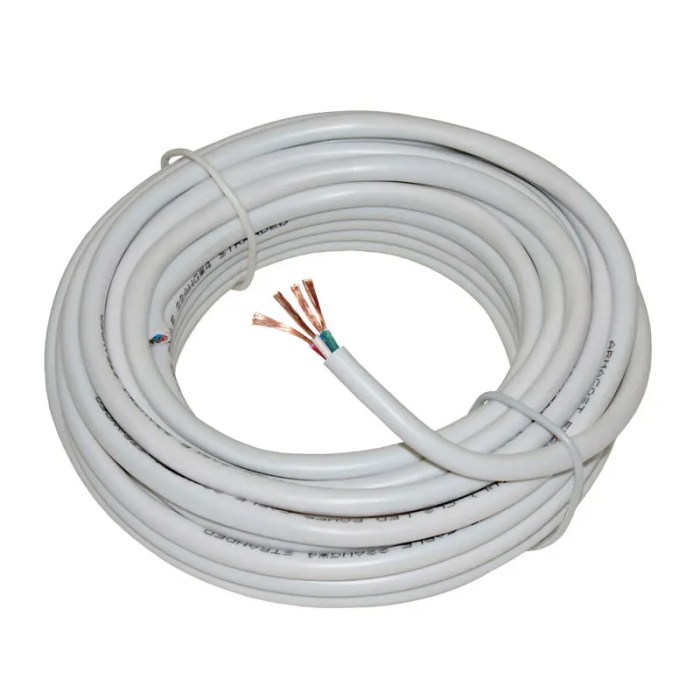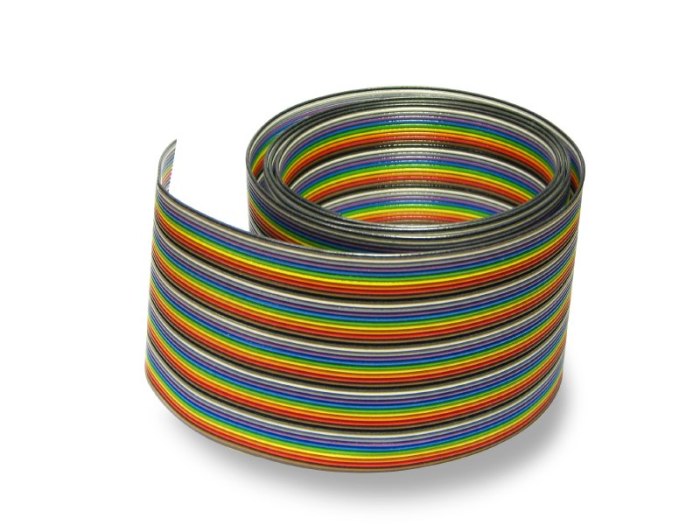Introducing the flat conductor cable type FCC, a groundbreaking solution in the world of electrical wiring. Its unique design and exceptional performance set it apart from traditional round cables, making it the preferred choice for a wide range of industries and applications.
Dive into this comprehensive guide to discover the intricacies of FCCs, their construction, electrical properties, installation techniques, and the vast array of applications where they excel.
Flat Conductor Cable Type FCC
Flat conductor cables (FCCs) are a type of electrical cable that features conductors arranged in a flat, ribbon-like configuration. Unlike traditional round cables, FCCs offer unique advantages and are widely used in various industries and applications.
Unique Characteristics and Advantages
- Compact Design:FCCs have a slim profile, allowing for space-saving installations in tight or confined areas.
- Flexibility:The flat design provides flexibility, making FCCs ideal for applications requiring frequent bending or movement.
- High Current Capacity:The wide, flat conductors enable FCCs to carry higher currents than round cables of comparable size.
- Easy Installation:FCCs are typically easier to terminate and install than round cables due to their flat shape.
- Cost-Effective:FCCs can be more cost-effective than round cables, especially in applications requiring large quantities or custom lengths.
Common Applications
FCCs are commonly used in various industries and applications, including:
- Automotive:Wiring harnesses, lighting, and sensor connections
- Consumer Electronics:Flat-panel TVs, laptops, and mobile devices
- Industrial Automation:Robotics, conveyors, and control systems
- Medical Equipment:Patient monitoring, imaging systems, and surgical instruments
- Telecommunications:Data transmission, network infrastructure, and telecommunication devices
Construction and Design of FCCs
Flat Conductor Cables (FCCs) are constructed with specific materials and designs to meet various application requirements. Understanding the construction and design of FCCs is crucial for selecting the appropriate cable for a particular application.
Materials Used in FCC Construction
- Conductors:FCCs typically use copper or aluminum conductors. Copper provides excellent conductivity and is commonly used in high-frequency applications. Aluminum is a lightweight and cost-effective alternative for low-frequency applications.
- Insulation:The insulation material in FCCs provides electrical isolation between the conductors and protects them from external influences. Common insulation materials include polyvinyl chloride (PVC), polyethylene (PE), and fluorinated ethylene propylene (FEP).
- Shielding:Shielding is often incorporated into FCCs to minimize electromagnetic interference (EMI) and radio frequency interference (RFI). Shielding materials include copper foil, braided copper, and metalized polyester.
Types of FCC Constructions
FCCs come in various constructions to suit different applications:
- Parallel Construction:In parallel construction, the conductors are arranged in parallel rows with insulation separating them.
- Twisted Pair Construction:Twisted pair construction involves twisting pairs of conductors together to reduce crosstalk and improve signal integrity.
- Shielded Construction:Shielded FCCs have an additional layer of shielding material wrapped around the conductors to minimize EMI and RFI.
Internal Structure and Design
The internal structure of FCCs varies depending on the construction type. Here are some illustrations to demonstrate the typical designs:
- Parallel Construction:
 In parallel construction, the conductors are arranged in parallel rows with insulation separating them.
In parallel construction, the conductors are arranged in parallel rows with insulation separating them. - Twisted Pair Construction:
 In twisted pair construction, pairs of conductors are twisted together to reduce crosstalk and improve signal integrity.
In twisted pair construction, pairs of conductors are twisted together to reduce crosstalk and improve signal integrity. - Shielded Construction:
 In shielded construction, the conductors are surrounded by a layer of shielding material to minimize EMI and RFI.
In shielded construction, the conductors are surrounded by a layer of shielding material to minimize EMI and RFI.
Electrical Properties and Performance

Flat conductor cables (FCCs) exhibit unique electrical properties that distinguish them from other cable types. Understanding these properties is crucial for optimizing FCC performance in various applications.
The electrical characteristics of FCCs primarily involve capacitance, inductance, and impedance. These properties influence signal transmission, power handling, and overall cable performance.
Flat conductor cable type FCC is widely used in high-power applications, as it offers low resistance and high current-carrying capacity. Like the ATP free energy carrier , which plays a crucial role in cellular energy metabolism, FCC cables are essential components in power distribution systems, ensuring efficient transmission of electrical energy.
Factors Affecting Electrical Performance
Several factors can impact the electrical performance of FCCs, including:
- Cable length:Longer cables exhibit higher capacitance and inductance, affecting signal propagation and power loss.
- Frequency:The frequency of the transmitted signal influences the impedance and attenuation characteristics of the cable.
- Temperature:Temperature variations can alter the electrical properties of the cable materials, affecting its performance.
Comparison with Other Cable Types
FCCs offer distinct advantages and disadvantages compared to other cable types, such as coaxial cables and twisted pair cables.
| Property | FCC | Coaxial Cable | Twisted Pair Cable |
|---|---|---|---|
| Capacitance | Higher | Lower | Medium |
| Inductance | Lower | Higher | Medium |
| Impedance | Characteristic | Constant | Balanced |
Installation and Termination

Installing and terminating FCCs requires specific methods and techniques to ensure proper functioning and reliability. The process involves careful preparation, handling, and specialized tools to achieve optimal performance.
The installation process typically involves planning the cable routing, preparing the termination points, and securing the cable using appropriate methods. Termination involves connecting the FCC to terminals or connectors using crimping, soldering, or other techniques.
Methods and Techniques
- Planning Cable Routing:Determine the path for the FCC, considering factors such as accessibility, bending radius, and potential interference.
- Preparing Termination Points:Prepare the terminals or connectors by stripping the insulation and ensuring proper contact surfaces.
- Securing the Cable:Use cable ties, clips, or other methods to secure the FCC along its route, ensuring it is protected from damage and strain.
- Crimping:Use a crimping tool to create a secure connection between the FCC and terminals or connectors by applying pressure to deform the metal contacts.
- Soldering:Solder the FCC to terminals or connectors using a soldering iron to create a permanent and electrically conductive joint.
Tools and Equipment
- Crimping tool
- Soldering iron
- Wire strippers
- Cable ties or clips
- Insulation displacement connectors (IDCs)
- Multimeter for testing continuity
Applications and Use Cases

Flat Conductor Cables (FCCs) are versatile and widely used in various industries, offering unique advantages for specific applications.FCCs are commonly employed in data centers due to their ability to handle high-speed data transmission and withstand harsh environmental conditions. Their compact size and flexibility make them suitable for dense cabling environments, reducing clutter and improving airflow.In
industrial automation, FCCs are valued for their durability and resistance to electromagnetic interference (EMI). They are used in robotic systems, conveyor belts, and other automated machinery where reliable and uninterrupted signal transmission is crucial.Medical devices also benefit from FCCs due to their flexibility and ability to conform to complex shapes.
They are used in patient monitoring equipment, surgical robots, and imaging systems, enabling precise and reliable data transfer in critical healthcare settings.
Standards and Certifications

Flat conductor cables (FCCs) are subject to various industry standards and certifications that ensure their quality, reliability, and performance. Compliance with these standards is crucial for manufacturers and users alike, as it guarantees that the cables meet specific requirements and specifications.
Relevant Standards and Certifications
Several organizations establish standards and certifications for FCCs, including:-
- Underwriters Laboratories (UL)
- Canadian Standards Association (CSA)
- International Electrotechnical Commission (IEC)
- American National Standards Institute (ANSI)
- Institute of Electrical and Electronics Engineers (IEEE)
These standards and certifications cover various aspects of FCCs, including:-
- Electrical performance
- Mechanical properties
- Environmental resistance
- Safety requirements
- Installation guidelines
By adhering to these standards and certifications, manufacturers can demonstrate the reliability and quality of their FCCs, while users can be confident that the cables they are using meet the necessary requirements for their specific applications.
Market Trends and Future Developments
Flat conductor cables (FCCs) are gaining significant traction in various industries due to their unique advantages and growing demand for flexible and space-saving solutions. Recent market trends indicate a surge in the adoption of FCCs, driven by advancements in technology and the increasing need for efficient power distribution and signal transmission.
Emerging technologies, such as the Internet of Things (IoT) and electric vehicles (EVs), are creating new opportunities for FCCs. The compact and flexible nature of FCCs makes them ideal for applications in these industries, where space constraints and weight reduction are critical factors.
Potential Applications and Advancements, Flat conductor cable type fcc
- Enhanced flexibility:FCCs offer superior flexibility compared to traditional cables, making them suitable for applications where frequent bending or movement is required.
- Space optimization:The flat profile of FCCs allows for efficient space utilization in tight spaces, such as control panels or electronic devices.
- Improved signal integrity:FCCs provide excellent signal integrity due to their controlled impedance and reduced crosstalk, making them suitable for high-speed data transmission.
- Weight reduction:The lightweight nature of FCCs makes them ideal for applications where weight is a critical factor, such as aerospace and automotive industries.
Expected Growth and Adoption
The market for FCCs is expected to experience significant growth in the coming years. The increasing demand for flexible and efficient power distribution and signal transmission solutions is driving the adoption of FCCs in various industries, including:
- Consumer electronics
- Automotive
- Industrial automation
- Renewable energy
- Medical devices
Essential Questionnaire: Flat Conductor Cable Type Fcc
What is the primary advantage of flat conductor cables over round cables?
Flat conductor cables offer several advantages over round cables, including their low profile, flexibility, and ease of installation. Their flat design allows for tighter bundling, resulting in space savings and improved aesthetics.
What are the different types of FCC constructions?
FCCs come in various constructions, including parallel, twisted pair, and shielded. Parallel FCCs consist of flat conductors laid side by side, while twisted pair FCCs have conductors twisted together to reduce electromagnetic interference. Shielded FCCs incorporate a metallic layer to provide additional protection against external noise.
What factors affect the electrical performance of FCCs?
The electrical performance of FCCs is influenced by factors such as cable length, frequency, and temperature. Longer cables exhibit higher capacitance and inductance, which can affect signal integrity. Higher frequencies also lead to increased attenuation, while elevated temperatures can impact the cable’s resistance and current-carrying capacity.